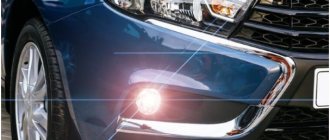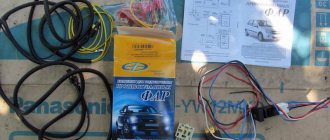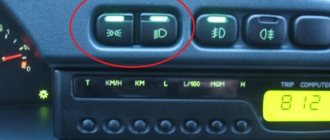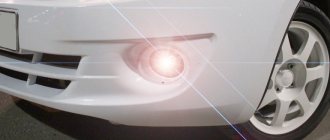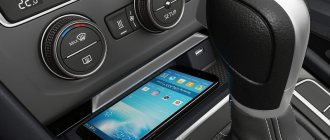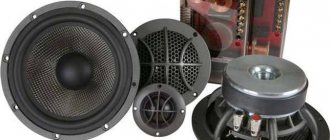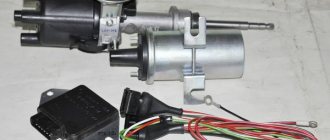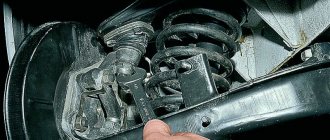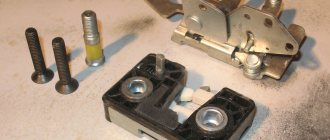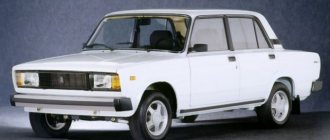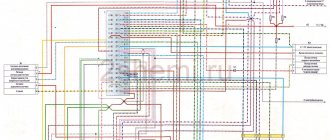Adjusting the front optics of Almera Classic
The front optics of Almera Classic are adjusted according to the drawn diagram. The cut-off line should coincide with the broken lines. If alignment is not observed, each headlight is adjusted using two screws. One is responsible for the horizontal plane, the other for the vertical.
The high beam is adjusted so that the resulting light beam hits the center of the marking. It is difficult to achieve this in the field without special equipment. For this reason, a number of car owners prefer to entrust the work of adjustment to service workers.
PTF connection diagram for VAZ-2107, 2105 and 2104 via a standard fuse box
Today we will tell you how to connect fog lights on VAZ-2107, 2104 and 2105, using the standard fuse block, and protecting each PTF with a separate fuse in this block. This PTF connection diagram is interesting because there is no need to drill or pull anything from the interior under the hood; we use standard unused tracks in the block, the so-called reserve ones. It is reliable, practical and convenient. In our diagram, the PTF switch is shown in yellow and it will be supplied with power from connector Ш2, terminal number 3 (pink wire). That is, 12V will appear on it when the dimensions are turned on. The orange wire must be connected to the Ш4 connector, pin number 5. It should be noted that if terminal 5 in the Ш4 connector is not used in the classic, i.e. It is enough to have a terminal on the wire and insert it into the connector, then terminal 3 in connector Ш2 is activated. Therefore, in this situation, you need to have an adapter connector on the wire or connect two wires to each other using a connector. This completes the connection from the car interior to the unit.
Connections in the engine compartment are also made by inserting prepared wires with a terminal at the end into standard wiring connectors. Connectors Ш9, Ш11, Ш6 and Ш7 are used. I describe them in order, and if connected correctly, all connection points are not used by standard wiring. Remove connector Ш9 from the block and insert the wire from the headlight (they are shown in black in the diagram) into contact 1 and the wire from relay terminal 30 into contact 3. Insert connector Ш9 into place. The figure shows the removed connector Ш9. In it, the yellow wire from the headlight is inserted into pin 1, and the green wire from the relay is inserted into pin 3.
Next, remove connector Ш11 and insert the wire from the relay into pin 8 - terminal 85. Terminal 86 of the relay is connected to ground using a wire at the end of which there is a round terminal for a self-tapping screw. I placed the relay along the stem of the washer fluid barrel. Fundamentally, it does not matter if you confuse legs 85 and 86 with each other. After returning connector Ш11 to the block, it is necessary to remove connector Ш6 from the block. Insert the remaining wire from terminal 67 from the relay block into pin 8. We connect the Ш6 connector back into the block and all that remains is to insert the last wire from the second headlight into the Ш7 connector, pin 1. The figure shows the Ш7 connector (green) and the yellow wire from the second headlight in it .
The wiring of the block is made in such a way that this circuit uses fuses
number F3 and F4 for each headlight separately. In the event of a short circuit on the lamps in the headlights, the corresponding fuses must operate. Their rating is 7.5A with a 55W headlight bulb, or 8A if an old type fuse box is used. It should be remembered that power is supplied to the relay from fuse F1, which has a rating of 10A. It is advisable to change it to a nominal value of 15A, and for the old-style block 16A. That's all the description, I hope our article helped you!
Installation and connection of front and rear PTFs on VAZ 2113, 2114, 2115
Before you begin installing fog lights, you will need to select a certain list of tools and additional elements. You can purchase a ready-made connection kit or select the necessary spare parts separately. When everything is prepared, you can mark on the front bumper a place for installing future headlights. The VAZ 2115 comes with standard holes from the factory, but in the case of the VAZ 2113 and VAZ 2114 you will need to work with a tool (a jigsaw or a drill). If you don’t want to damage the bumper, you can install the lighting fixtures on special brackets.
To install foglights in the front bumper, you need to make holes using a jigsaw or drill with drill bits, having previously completed the markings
Installation Tools
You will need:
- file;
- drill and drill bits;
- electric jigsaw;
- roulette;
- marker.
We recommend: How to check the variator when buying a car
Installation materials
As a rule, the kit for installing PTF on VAZ 2113, 2114, 2115 includes the following elements:
- headlights with bulbs;
- set of wires;
- electromagnetic relay;
- PTF power button;
- ties and clips for fixing wires;
- PTF connection diagram VAZ 2113, 2114, 2115.
The kit for connecting fog lights should include wires with terminals and connectors, a relay, a button
The installation of the lighting sources in question must be carried out using a button and an electromagnetic relay. The fact is that fog lights consume quite a lot of current and connecting directly to the ignition switch will lead to burning and subsequently burnout of the contacts. All this can contribute to damage to the wire insulation and the occurrence of a short circuit, which may result in failure of the electrical wiring.
Step-by-step installation and connection of PTF
To install fog lights, the following procedure must be followed:
- Installation of the headlight switch button in the cabin.
You can choose any location for the element, as long as the driver can easily operate the key. Quite often, the part is installed instead of plugs on the dashboard. The PTF activation key is usually located instead of one of the plugs located on the dashboard - The grille with the dynamic head is removed from the front panel. Behind it there are two blocks designed to turn on the headlights, indicate the operation of the PTF and illuminate the button.
- Having placed the button in a convenient place, connectors are connected to it. After this, the grate can be put back in place.
- The relay is installed under the hood on the partition of the engine compartment near the mounting block. To remove it, you need to unscrew 2 nuts, lift it and find 2 pads (numbers 7 and 8).
The relay is fixed near the mounting block, for which it is necessary to unscrew the two fastening nuts
- A block with a harness of four wires with contacts included in the kit is laid to the relay block.
A wiring harness with four contacts, which is included in the kit, is laid to the mounting block
- The connection of the wires that come from the PTF relay is carried out according to the diagram in the following order: the wire from the 30th contact of the relay is connected to block No. 8 of the mounting block at the 8th terminal, the 87th contact of the relay goes to the 1st terminal of the connector, 86 is “ground”, and 85 is connected with the 17th terminal of block No. 7.
Diagram for switching on fog lights: 1 - fog lights; 2 — relay for turning on fog lights; 3 — mounting block; 4 — fog lamp switch with a control lamp (on the left) and a backlight lamp (on the right); 5 — external lighting switch (fragment); A - to power supplies; B - to the instrument lighting regulator
- The positive wires are pulled to the PTF, the mass is mainly secured to the nut of the headlights. The “+” voltage is supplied to the fog lights from the 2nd and 3rd contacts of block No. 8.
The ground is attached to the headlights, the positive wires are connected to pins 2 and 3 of block No. 8
- After all connections, the connectors are installed in the mounting block and secured.
As for the rear PTFs on VAZ 2113, 2114, 2115, on these modifications of the car such a light source is installed from the factory, i.e. another light bulb is used in the rear light. Control is also carried out from the passenger compartment using a button, but without fixing, since a slightly different relay design (electronic) is used. It’s worth knowing about this and not trying to install a latching key.
Video: installing PTF on a VAZ 2114
Checking the performance of PTF on VAZ 2113, 2114, 2115
After the lighting devices are installed and connected, you need to check how correctly everything works. To do this, just turn on the headlights and press the key that supplies voltage to the PTF relay, after which the headlamp lamps should light up. When the headlights are turned off, the PTF lamps should also go out, regardless of the position of the fog light button. After checking the functionality of the light source, you will need to adjust the light output so that oncoming drivers are not dazzled.
After installation and connection, we check the operation of the PTF: when the lights are turned on and the fog lights are pressed, the lights should light up, when the lights are turned off, the lights should go out
Fog optics are essential lighting equipment for any car. Such devices greatly facilitate travel in poor visibility conditions. If a certain car model does not have PTF installed from the factory, you can carry out the installation yourself. This does not require special tools or special skills and knowledge.
Who determines the level of responsibility?
The traffic police officer decides on the spot whether to issue a fine or limit himself to a warning. He looks at the situation, how the driver behaves, how often he had violations, and other mitigating or aggravating circumstances.
It's more of a human factor. But for the first such violation, you can count on a written warning.
If a car gets into an accident with the exterior lights not turned on, it automatically becomes the culprit of the accident! Even if he complied with all other traffic rules and was not actually at fault.
Driving without running lights or daytime running lights on automatically creates an emergency situation on the road, because the car becomes less noticeable to other road users.
If a traffic police officer is going to issue a fine, but the driver does not agree, then a protocol is first written, and then a decision is made.
The driver has the right to challenge the decision of the traffic police officer in the traffic police department or in court if he has arguments in his defense. To do this, the protocol must describe as accurately as possible what the driver disagrees with and what the road conditions were.
It is advisable to provide a photo or video confirming the absence of a violation. In special cases, even a voice recorder recording of a conversation with a traffic police officer can help the driver! The driver is given only 10 days to challenge.
Penalties for not turning on running lights are small - this is the minimum fine for violating traffic rules
But the importance of switched on, and most importantly, correctly switched on lights is very often underestimated by road users
If a car does not have illumination, it can simply not be noticed or mislead other drivers.
Such carelessness can lead to serious accidents. Therefore, for your own safety, never forget to turn on your daytime running lights or low beams - make your presence known on the road!
Therefore, for your own safety, never forget to turn on your daytime running lights or low beams - make your presence known on the road!
Using devices during daylight hours
Paragraph 19 of the traffic rules determines that it is necessary to turn on the lights on the car both during the day and at night. If lighting devices are used incorrectly, the responsible person may be fined in the following cases:
- High beams are turned on in areas where the rules for built-up areas apply. This situation is especially common in the dark, when after driving along a country road the driver forgets to switch the headlights to low.
- Using fog lights instead of low beam headlights. The traffic regulations recommend using fog lights when road visibility is not particularly good, if traffic occurs during heavy rain, in fog, or during a snowstorm.
- Cars driving at night with running lights on. Many distracted drivers make mistakes. With daytime running lights used throughout the day, sometimes when it gets dark, drivers forget to switch to the correct light.
When can you do without it?
- During the daytime, you can drive without low beams by turning on the daytime running lights or fog lights. This can be done provided that the movement does not occur in poor visibility, which is not enough for a correct assessment of the road situation. Otherwise, the chosen approach is considered a violation.
- At night, turn on either low or high beam headlights.
It is not always possible to use high beams - if there is lighting in a populated area, it is prohibited, and you should not turn it on if there is a possibility of blinding oncoming drivers. If visibility is insufficient during daylight hours, you can also drive using high beams, except in prohibited situations.
Cases in which to include
- Lighting devices must be available on any mechanical vehicle; this list also includes horse-drawn carts and bicycles, which are not required, but it is recommended to use devices with bright light when driving.
- For trailers and towed vehicles, it must be possible to equip them with side lights.
- It is necessary to keep the lights on at all times - for example, during daylight hours when driving in the city, low beams should be turned on to prevent accidental blinding of other persons driving oncoming vehicles. When the driver uses running lights, there is no need to turn on the low beam in addition.
- At night, after sunset, if visibility is poor, the driver can use high beams if he is sure that he will not blind the driver driving oncoming traffic.
Adjusting the fog lights
Fog lights (PTF is an abbreviated designation) on a car perform an important task. They help the driver to see oncoming traffic even in situations where thick fog reflects the light beams of the head optics. The rays coming from the fog lights should go below the main light and be parallel to the road.
With prolonged use, the factory settings are lost, so adjustment is required. On Almera Classic, the fog lights are adjusted as follows:
- The distance from the center of the fog lights to the surface on which the machine is installed is measured. The corresponding distance is measured on the wall and a horizontal line is drawn.
- The second line is drawn above the first at the same distance.
- Vertical segments are drawn on the diagram taking into account the position of the centers of the car and PTF.
- The car is driven 10 m away from the wall, the fog lights turn on.
- Use the adjustment screws to ensure that the centers of the light spots coincide with the points of intersection of the horizontal and vertical lines (for the right and left PTF).
- The rays descend until the upper boundary of the light spot is 10 cm from the drawn horizontal line.
Connection diagram
All that remains is to connect our fog lights to the car’s on-board network. In the VAZ 2107 this is not difficult to do, since the mounting block has places for installing fuses, and all the wiring from them is routed to the blocks. But, of course, you will have to buy something in addition. Additionally we will need:
- Relay with a block for it.
- Fog light switch with a socket for it.
- Female terminals for knife blocks.
- Special automotive wires (for example, PGVA brand).
- Three fuses: one 15 and two 7.5 A.
- Two 55 W halogen lamps with H3 socket (not included with headlights).
Installation kit for connecting fog lights in a VAZ 2107 We won’t bother with the electrical circuit diagram. Let’s just assume that we don’t know how to read them and limit ourselves to the wiring diagram.
Wiring diagram for connecting fog lights in a VAZ 2107
In the diagram, the markings Ш4, Ш6, Ш7, Ш11, Ш9 indicate the blocks of the mounting block, below them, from left to right: the side light switch, fog lights (we will install it ourselves) and the head light switch.
First of all, we are looking for the installation location of the fog light relay. The author of the photo decided to install it on the mudguard of the engine compartment.
Installed fog light relay (left)
Now we pull the wiring from the mounting block to the fog lights. Since our bumper is plastic, we will also pull the ground wire along with the power wire.
We install and connect fog lights on a VAZ-2114 with our own hands (video inside)
Power harness for fog lights in the engine compartment
For greater reliability, the wires can be inserted into a corrugated cable (preferably heat-resistant). We bring the wires out into the holes in the apron, crimp the ends of the wires with female-type terminals - we will put them on the contacts of the lamps.
Power wires for fog lights, routed through the apron
Now we open the mounting block (located in the engine compartment under the windshield opposite the passenger). In the photo below it is indicated by the number 5.
Location of the mounting block in the VAZ 2107 (position 5)
We dismantle it by unscrewing 2 nuts and get to the pads. We measure the wires of the required length, crimp the knife blocks onto them using pliers and assemble the diagram presented above. To do this, we turn off the pads one by one and insert the blade contacts into the required sockets - they must be empty. We extend the wire from block Ш4 into the interior to the installation site of the fog light switch. We will place it next to the side and head light switches in a free space covered with a plug.
Installing blade contacts into the mounting block blocks on a VAZ 2107
All is ready? We install the mounting block in place. Now let's take a look at the fuses. We are interested in those marked with arrows in the photo below. The green arrow marks a fuse common to both PTFs. It is installed initially because it also powers other circuits in the car. Its rating is 10 A, but we will replace it with fifteen amps, since the load on it will increase when installing fog lights. The red arrows indicate the fuses responsible for the left and right fog lights. Initially, they may not stand - there were no headlights on the car. We install 7.5 A fuses there.
Mounting block with installed fog light fuses
All that remains is to install and connect the fog light control button. We remove the decorative trim at the rear of the console for the gear shift knob and push out the plug from the inside, the side light button and the head light button. We assemble the circuit by cutting directly into the wires coming from the switches, connect to the wire passed from the mounting block, and install the buttons, including the new one, in place.
Fog light control button installed instead of a plug
At this point the work can be considered complete, turn it on and check it. Yes, we spent quite a lot of time tinkering with the bumper and wiring, but we got a real, high-quality fog light that won’t let us down and will keep us safe in any bad weather.
Bright headlights are the motorist's main assistants in the fight against bad weather and evening twilight. They should illuminate the road well so that you can be confident while driving even in the thickest fog. But if the light provided by standard headlights is not enough for you, we recommend installing fog lights on the VAZ 2107 for better visibility. You can do this yourself without resorting to the help of specialists. We will describe in detail below how to install correctly and how to choose “lanterns”.
Installation
The PTF installation process can be divided into three main stages:
- Installation of headlights;
- Network connection;
- Functionality check.
We recommend: Engine water hammer. Causes and consequences
So now we will talk about each stage separately.
Installing headlights
We will consider the option of installing PTF on a standard bumper. Therefore, it does not have holes for new optics. You will have to do them yourself.
To work you will need a certain set of tools and materials:
- File;
- Drill and drill bits;
- Electric jigsaw;
- Roulette;
- Marker.
Connection elements
Now directly about work.
- First of all, remove the bumper. Work is performed only if it is disconnected from the seat.
- Remove all dirt from the bumper.
- Make markings for the installation of future fog optics.
- It is best to mount the headlights slightly to the side of the lower air intake. Try to place the PTF strictly under the main optics of your car.
- For decorative glasses that have outer and inner halves, make markings. The outer half is decorative, and the inner half is designed to fix the outer part and headlights.
- The outer part of the glasses has a protrusion on the inside. With this mounting protrusion, the element should fit into the hole made in the bumper.
- To determine the optimal dimensions, you should measure the landing protrusion. This way you can make the appropriate markings on your bumper.
- Using an electric jigsaw, holes of the required size and location are cut.
- Use a file to file the cut areas.
- The outer part of the glasses should eventually fit tightly into the hole.
- Fog lights are mounted in the resulting holes. For this purpose, the kit includes special mounting bolts.
- Attach decorative glasses to the top of the headlights. The bumper can then be returned to its place.
Connection
Together with the PTF, a diagram for connecting the devices must be attached. It is not complicated, so even a beginner will be able to understand all the nuances of connecting the components to each other.
You will need to embed the wiring from the foglights into the mounting block, which is located in the engine compartment to the right of the windshield. To do this, just unscrew the bolts from the block, lift it and find the pads marked Ш7 and Ш8.
These blocks are used to connect fog lights, although these lighting devices are not installed standard at the factory. Wiring from the headlights and from the fog lamp relay, which is provided in the purchased PTF kit, is connected to these blocks.
Your job is to make the correct connection. This is done according to the following scheme:
- The output wire from pin 87 is ground, so you need to connect it to the car body;
- Pin number 85 goes to the block marked Ш7 and is connected to connector number 17;
- Pins numbered 30 and 86 go to block Ш8. In this case, connect pin 30 to connector 8, and lead 86 to connector number 1;
- Having installed the headlights, stretch the positive wire through the engine compartment, as they are connected to the Ш8 block. But these wires need to be inserted into connectors numbered 2 and 3;
- Now connect the block to the mounting block, and return the block to its place;
- Select an area near the block where the fog light relay will be installed.
Connection result
Button
Now all you have to do is connect the control system for your PTFs. Included with the fog lights is a corresponding button, which will stand on the panel in the seat provided by the manufacturer.
PTF button
The manufacturer, that is, AvtoVAZ, provided for this. Therefore, under the panel you will find a control block. The panel is removed, the corresponding block is located and the button is connected to it. That's it, the controls are ready.
Examination
The last stage is to check the functionality of your PTFs.
To check the efficiency of the lighting devices, turn on the headlights on your VAZ 2114, then press the button to turn on the fog lights. When the lights are turned off, even if the fog lights button is pressed, they should still go out.
The importance of PTF is difficult to overestimate. They help you see the road better during fog, rain, and snow. Moreover, fog lights are designed to improve the visibility of your car to oncoming and behind vehicles. Therefore, we strongly recommend installing PTF not only in front, but also in the rear.
Light and sound devices of the car and their location
We should start with the basics, or rather with what types of headlights and lanterns modern cars are equipped with.
Low beam headlights - designed to illuminate the road and surrounding area in a relatively small area.
High beam headlights are powerful lighting devices that illuminate the roadway over a fairly large area. Due to its high brightness, high beams can blind oncoming drivers.
Front fog lights - installed lower than conventional headlights, create a wide beam of light that well illuminates the road and the surrounding area in conditions of fog, snowfall and rain.
Daytime running lights are a separate type of headlights that are turned on during the day, regardless of weather or visibility, and are designed to increase the visibility of vehicles. Most models turn on immediately when the engine starts.
Tail lights - designed to identify the vehicle at night or in poor visibility conditions. The color of the lamps is red.
Brake lights are red lights that come on when a vehicle slows down. They burn much brighter than the side lights. Some cars are additionally equipped with a central brake light.
Rear fog lights - indicate the vehicle in fog, rain or snowstorm conditions. Not to be confused with brake lights.
Reversing lights are white and are designed to inform pedestrians and other motorists that the vehicle will be moving (or is already moving) in reverse.
Rear reflectors - used for the same purpose as side lights, they reflect the light falling on them from the headlights of passing cars. May also be known as retroreflectors.
License plate lighting – several white bulbs designed to illuminate the rear license plate of a vehicle.
Turn signals, or “turn signals,” are amber lights that are used to inform you that the vehicle is turning or otherwise maneuvering. Installed in the corners and on the sides of the car.
How to choose the right fog lights
However, fog lights are not always used only for such conditions. They can be perfectly used to illuminate those areas that are not illuminated by standard optics. This may be the right edge of the curb, the distance directly in front of the hood of the car. Naturally, this does not affect the range of light in any way, but fog lights will be useful to get a complete picture of the condition of the road surface.
The power of fog lamps is the tenth thing. That is why, whenever possible, it is better to use low-power light sources, and here, more than anywhere else, LED lamps look best. They can also be used as daytime running lights, the main thing is strict compliance with traffic regulations, otherwise they will only bring problems instead of benefit.
These norms are clearly described in the Rules, so we will not dwell on them. Therefore, the following arguments can be counted in favor of fog lights:
- improved visibility in difficult weather conditions - rain, fog, snowfall;
- improved viewing angles in normal night conditions;
- fog lights can be used as daytime running lights;
- The dimensions of the car in difficult conditions are better visible even from afar;
- Lens foglights will allow you to accurately focus the beam of light on unlit areas of the route.
In a word, if we decide to install fog lights of any type, not counting xenon ones, they need to be connected according to a completely different scheme, all that remains is to look at the diagram and, before connecting the fog lights via a relay, select the necessary components.
We recommend: Independent replacement of the vacuum booster on a VAZ 2114
Which fog lights are better for the VAZ-2110
Outwardly, you may not notice much difference between high-quality headlights and “analogs” of unknown origin.
We recommend: The process of replacing the water pump on a VAZ 2109 in the garage
Making the right choice in this case is very difficult, since a huge number of headlights have appeared on sale, different in shape, light source and color spectrum.
It is also important what material the diffuser is made of - glass or polycarbonate. Since PTFs are installed low, puny plastic cases do not last long
And if we take into account that in the rain we will often have to wipe the diffuser with improvised means, then the low-quality material will rub off and all the work of the lamps will go down the drain.
On the glass: the center of the headlight and the type of lamp.
Wires in a protective tube.
Strong mustache and lamp screen.
Adjustment screw with fine thread and spring.
Regular and similar PTFs
Rectangular fog lights with standard mounts fit into the VAZ-2110 bumper in a standard place without additional modifications. They are produced by a lot of manufacturers, but, again, all these headlights are different both in the quality of the optics and in the light source.
The most common are two types of domestically produced PTFs OSVAR and headlights from the Avtosvet plant from Kirzhach. The latter have two modifications - for a lamp with H3 and H1 sockets. According to user reviews, headlights with H1 lamps provide a denser and more concentrated luminous flux over the entire illumination range. Their price is about 900 rubles apiece. But they are sold without a lamp. Fog lamp Kirzhach.
Domestic headlights - OSVAR 2212.3743-04. They are assembled rather roughly and this spoils the appearance. The lampshade is non-removable and is glued in with sealant, which if damaged will affect the cost of replacement. However, with a price of about 700 rubles (with a lamp), they look pretty decent. The illumination is even, but if installed correctly, the near zone is illuminated worse. Farah Osvar.
Another relatively domestic manufacturer is the Ryazan Bosch plant
The headlights are designed for H3 lamps, the light doesn’t matter, but they also cost about 650 rubles. The most budget option for infrequent use
They are sold without a lamp. PTF from Ryazan Bosch.
PTF VAZ 2110, 2111, 2112
Wiring diagram for fog lights VAZ 2110 in VAZ 2112
I decided to add a photo of instructions for connecting fog lights, maybe someone will find it useful.
equipment (not all kits include a PTF power indicator, see the note on the package)
Connecting PTF to VAZ 2110, 2112, 2111 with an old panel
PTF button. 7 - weight, 9 and 10 on Ш1-5, 58R
Today I figured out how to connect the PTF. (Yesterday they started working, but then went out). The point was this: the Internet is full of diagrams with PTF relays. I did with him. Today I realized that a relay is not needed AT ALL. It heats up and turns off. It is needed for a short launch. It works on the principle of a magnet (current is conducted, the plate is magnetized, closes the contacts, and supplies “+”). In short, it is needed for short starts (for example, a starter). And here we need burning PTFs all the time. Therefore, we remove it from the diagram. (The fog lights go through fuses 4 and 14, so don’t be afraid that all the wiring will short out). Today I made a wiring diagram for fog lights, I hope it will help someone. The colors are conditional to make it easier to see, so look at the facts. I present to your attention a diagram for connecting fog lights. Well, my little engine :3
Installation and connection of PTF in VAZ 2110
The other day I finally got around to installing and connecting the PTF.
To begin with, I purchased in the store:
1. Fog lamp VAZ-2110 (for H1 lamp) Kirzhach (Avtosvet) 2110-3743010-03 — 800 rub; 2. Wiring VAZ-2110-12 fog lights SB kit AENK - 350 rubles 3. Frame fog lights VAZ-2110-2112 right + left 2111-2803192\2803193 - 100 rubles; 4. Lamps MAYAK H1 12V 55W ULTRA Super Light+90%; 5. Bolts M6x45 - 4 pcs; 6. Lambs M6 - 4 pcs.
Step 1: Installation of PTF
1. Covered the headlights with armor film yellow ORACAL 8300 No. 21;
2. Installed lamps Autolamp MAYAK H1 12V 55W ULTRA Super Light+90%; 3. Covered with silicone sealant all possible places where moisture could penetrate inside the headlight;
4. I removed the plugs for the fog lights on the bumper; to get to them, I had to work hard, since their fastening is located on the inside of the bumper, the plug is secured with two screws. I crawled up to them through the hood, the right one caused the most problems, it was very difficult to get to it;
right
left
5. I took the PTF, placed the frames on them and screwed the bolts into the mounting holes (the bolts go tight, cutting threads in the plastic). I used a head to screw them in, since it’s impossible to turn them by hand (be careful, the bolts get very hot!).
Well, and a bonus: hooligans will definitely not remove the fastenings with bolts from the outside without a special tool! (Just kidding, of course - who needs them to remove them))))
6. After installing the fog lights using the wings for fastening, in the future you can very conveniently and quickly install (dismantle) them!
in the future I will change the PTF connection pads to the VAZ-2108-2110 crankshaft sensor pads, since they have an elastic band and a sealed connection to protect the contacts from moisture!
The headlights are in place. And the bolt heads had to be painted black
Step 2: Connecting PTF:
1. To install the PTF wiring, I used the PTF connection kit, the only negative in this kit is the lack of a PTF on indicator, and finding it later became a problem for me, so take the complete kit;
2. First of all, I laid the (+) wires in the corrugation, the wires turned out to be long (shortened);
3. I laid them through the hole where the hydraulic corrector tubes were laid (but this method is complicated, since you have to remove the frill and the wiper drive motor), I saw that many people lay them through the hole in the clutch cable. (I think this is not safe, the wire may wear out over time, and it’s not far from the short circuit) or they drill a new one (drilling is also not my option).
removed the frill, wiper motor
removed the plug
4. Afterwards we are already working with the mounting block (I used the instructions included in the PTF connection kit; everything is described in detail and clearly.
The only difficult thing was that I had to remove the terminals from the blocks, and since the wires were thick and there was no crimping, I soldered the wires together and to the terminals, then crimped them with pliers, covered them with heat shrink and installed them back into the block (but now everything is held tightly).
5. Check the headlights, everything works!
Step 3: Adjust the position of the headlights using the adjustment screw.
Connecting PTF VAZ 2112 (European panel)
under the hood there should be factory wiring for PTF, we find these chips in the area of the fog lamp plugs under the main headlights
the wires under the hood go into this chip to the control unit
Next, I bought a ready-made PTF connection kit for the Europanel with a button, relay and wires, the black wire from the relay was screwed to ground under the panel
we need to connect 5 wires, 2 blue wires with one side are put on the finished wiring chip near the block, the other ends are inserted into block Ш1 into cells 1 (yellow-black wire) and 6 (yellow wire (I have them shown with arrows with numbers 5 and 4 ,. then the orange wire into block Ш1 in cell 8 (for me it’s arrow 2), there are 2 red wires left from the relay, so we insert the red wire from (relay 87) into block Ш1 into cell 5 (for me it’s arrow 3), and insert the second red wire from relay 30 into block Ш3 in cell 6 (I have an arrow with the number 1 and that’s it, the work is finished
everything is working
Installation of Il Trade xenon in PTF VAZ 2112
I bought a set of Korean xenon lights from the company avtosvet.pro, great guys work there, great prices.
The car had "under-LED daytime running lights" that were damaged and had clearly not worked for a long time.
I bought new fog lights (body + glass) from Autotrak for 600 rubles, without wiring.
I borrowed the plastic holder from “nedoddkho”.
The new xenon lamps did not fit into the socket; for some reason it was rectangular; the plastic on the lamps had to be slightly modified. I clamped them tightly with staples and filled the whole thing with silicone sealant.
+ I also applied silicone along the contour of the glass to the headlight housing.
Let's try the finished wiring with ignition units
The blocks were taken SLIM, which means thin, so that they were easy to attach
Then we put everything in its regular place, connect the wiring, attach the blocks and enjoy the view.
+ In the dark, I adjusted the night lights a little, turning them as far down as possible so as not to blind the drivers.
https://www.drive2.ru/l/914403/
https://www.drive2.ru/l/5766990/, https://www.drive2.ru/l/4696923, https://www.drive2.ru/l/6583984/
next article:
Making DRLs with your own hands and wiring diagram for DRLs with turn signals for VAZ 2110, 2111, 2112
Contents of the article: 1. Making DRLs with your own hands for VAZ 2110, 2111, 2112 2. Connection diagram for DRLs with a turn signal for
Rating 1.00 [1 Vote]
Installation of fog lights (PTF) on a VAZ 2107
Fog lights have long won the sympathy of car enthusiasts. First of all, thanks to a significant (several orders of magnitude) improvement in visibility in difficult road conditions.
In the autumn-winter period, when daylight hours are short and unfavorable weather conditions become almost the climatic norm, fog lights help you move safely and be seen even at a great distance.
Fog lights for VAZ are both an increase in the safety of your car and, at the same time, tuning. In poor visibility, a VAZ with fog lights looks quite like a representative foreign car. Fog lights are two additional headlights that are placed close to the ground clearance.
Tools required for work:
- drill (electric or battery);
- a screwdriver and a hammer - just in case.
What else is useful in the work is wiring (at least a couple of meters), a female connector, an on/off button; four-stroke relay. And - of course - hands growing from the right place.
Tip: It is most convenient to install fog lights if you first remove the bumper. It’s easier (especially for novice car enthusiasts) to use for installing PTFs in places where the standard ones are installed.
The work on installing fog lights (FTL) on a VAZ 2107 takes place in several stages:
- We are preparing the field for installing fog lights. Using a drill, we drill a hole into which the mount for the fog light could be placed. You can step back approximately 15 centimeters from the opening for the number to ensure that nothing interferes with the implementation of the idea.
Depending on the location of the lamp power relay, it is necessary to consider the location of the wiring. If the relay is located under the hood on the right, power can be continued near the battery under the mudguard, then through the pipe and bumper mount.Using the same drill, we create three holes for the wires that will connect the left and right fog lights. We secure the wiring using copper wire (copper is not subject to corrosion and is more durable than, for example, steel, and it is more convenient to work with it, due to its greater flexibility.
- Installing fog lights. We install the mounts for our new headlights, and we can put the bumper back in place.
After installing the bumper, we disassemble the PTF and install the lamps in the right places. The rear parts of the lights are placed on the mounts, and new wiring is connected to them.We clean and crimp the connectors, then connect the light bulbs and reassemble the headlight. The process is carried out in reverse order.
Work with another fog lamp is carried out in a similar way.
- Connecting fog lights.
The connection diagram is quite standard and detailed descriptions are hardly needed in this case.We check the functionality, and if everything is in order, we rejoice at the new successful experience. If necessary, you can also adjust the headlights.
Methods for installing PTF on VAZ 2113, 2114, 2115
Installation of fog lights can be done in several ways. Which one to choose, each car owner decides for himself, based on his capabilities and preferences. Let's look at the most common installation options:
- Buying a front bumper with PTF. In this case, the headlights are sold already mounted in the front bumper. As a rule, a part can be purchased without any problems at a car tuning studio and immediately installed and connected. The disadvantages of this option include high financial costs.
Buying a bumper with PTF installed is the most expensive option for installing fog lights on a car.
- Buying a bumper with holes for PTF. With this installation method, you should purchase a bumper with holes for the lights and the headlights themselves with all the necessary elements (wires, relays, power button, etc.).
When purchasing a bumper with holes for fog lights, you will need to purchase the lights themselves and all the necessary components for connection
- Self-installation of PTF is the most common installation method, since it requires minimal financial investment. The car owner only needs to purchase headlights with the necessary installation kit and facing elements.
The most common option for installing PTF is to purchase and then install a set of fog lights yourself.
PTF location diagram on a car
Before connecting the fog lights, it is important to install the devices correctly on the front of the car. This is done in accordance with certain rules, which clearly stipulate the location of the light source. On modern cars, the installation locations for fog lights are marked from the factory. Basically, such lighting elements are installed on more expensive car configurations. If the headlights were not installed from the factory, then the places for their installation are closed with plugs.
Fog lights on the front of the vehicle must be installed in accordance with established regulations
We recommend: How to insulate a car engine for the winter
Is it possible to install xenon in PTF
Many car owners seek to install xenon in fog lights, arguing their actions by increasing lighting efficiency. Is this really true? Let's figure it out. First of all, when installing xenon in standard PTF housings, focusing is disrupted, which is due to a different operating principle in contrast to conventional lamps. Since standard fog lights are designed to operate with certain lamps, they simply cannot cope with xenon. The result of such changes will be too much reflection in the reflector, the rays are refracted, and the light becomes blurred. A well-known situation arises - the blinding of drivers of oncoming vehicles, which increases the risk of an accident. Installing xenon in PTF is far from the most successful solution and the effectiveness of such light is questionable, so it should be abandoned.
When installing xenon light in standard fog lights, focusing is disrupted, which leads to dazzling oncoming drivers
Video: how to choose fog lights
Connecting fog lights VAZ 2107
1. In principle, there is nothing special to describe, the circuit is quite standard, the only thing is that in my car 12V is supplied to the button only when the dimensions are turned on.
2. I have a torpedo from the “five” and a beard from a VAZ 2107, so there is more than free space... If you want, you can come up with something of your own.
So the exciting moment is the performance check. If you, like me, have everything working, you can rejoice and safely assemble the instrument. You may need to adjust the headlights upon completion.
This experience demonstrates once again that you shouldn’t be afraid, you need to boldly take it and do it, so installing fog lights on a VAZ 2107 is not as scary as it might seem at first glance. The result will pleasantly surprise you, in the evening everything looks quite beautiful, everything is clearly visible in the fog, visibility is good, so time and money were not wasted
Thank you for your attention, I hope the article is useful to you. See you again on the VAZ Repair website
Adjustment process
This work can be divided into two stages - preparing everything necessary and directly adjusting the light flux. Let's look at each of them in more detail.
Preparatory work
At this stage you need to do the following:
First of all, make sure that your equipment is working correctly and is turned on separately, and not together with the low beam headlights. If you have done everything in a homemade way, redo the design as it should be; the diagram below will tell you the correct connection procedure.
- Next, you need to check the reliability of the fastening of your PTFs; if they are loose, the adjustment will be useless. Another important nuance is the tire pressure; it must be the same so that the car stands without tilting.
- To set up, you should find a flat area with a wall or a smooth, solid fence in front of it. After this, the distance from the ground to the axis of position of the fog lights is measured, and a horizontal line is drawn on the wall at this height.
- Then the car is placed at a distance of 5 meters from the surface, at this point the preparation can be considered complete, as you can see, there is nothing complicated here, you will do all the steps with your own hands in literally 10 minutes.
Settings
Now let’s directly look at how to adjust the fog lights of a VAZ 2110; the instructions for carrying out the work are as follows:
Once the distance is set, you can begin adjusting the height. Again, it is better to adjust each headlight separately; the center of the light flux should be on the axis of the light elements; adjustment is made using a special screw located on the side; for this purpose, there is a hole for a screwdriver in the frame.
Once the work is completed, you will receive a light that meets the standards, which will provide excellent visibility even in the most difficult conditions. The photo shows an example of a PTF with xenon light; the brightness of this option is much higher than standard modifications with incandescent lamps. Do not forget about the correction if, for example, you have a towbar installed and you are towing a trailer.
How to install and connect with your own hands?
Installing fog lights on your own begins with developing a connection diagram. A properly designed circuit avoids unnecessary wires and ensures reliable operation of the electrical circuit. It is recommended to carry out installation work in the garage, although many owners install it outdoors.
Installing PTF in the front bumper and setting it up
There are three installation methods:
- into standard openings;
- on the outer bracket;
- into a blank bumper not intended for installing headlights.
The setup is done using the homemade template presented below. The template is installed perpendicularly at a distance of 5 m from the car headlights. The adjustment is made until the top edge of the light spot coincides. The matching line is located 100 mm below the height of the center of the lamps.
Approximate view of the template for customization
Adjusting your fog lights increases driver visibility and reduces the risk of blinding oncoming drivers.
Installing PTF in a blind bumper
The most difficult and time-consuming option is to install fog lights in a solid bumper (i.e., one that does not have factory holes for this):
- Remove the bumper from the vehicle in accordance with the repair and operating instructions.
- Determine the optimal location for installing headlights in terms of housing shape and compliance with regulations.
- Make a hole for the headlights. The best way is to drill holes around the perimeter and saw through the gaps with a file. The hole must be adjusted to ensure proper fit between the body and the decorative frame. Small fragments of the bumper are carefully cut off with a construction or stationery knife.
- Drill holes for the fog lamp housing, which is secured with suitable bolts.
- Install the headlight into the housing and mount the protective cover. It clings to the plastic of the bumper.
- You can adjust the headlight using a special key included in the kit.
View of the bumper without fog lights
Bumper removed for work
The method of obtaining the window is clearly visible
Frame installation and adjustment
Beginning of reinstallation and connection
The car is assembled
Installing PTF on the external bracket
Option for mounting foglights on a steel bracket:
- Mark the mounting points of the bracket on the bumper in accordance with the requirements for installing fog lights. As a rule, additional headlights are installed on the bracket.
- Screw the bracket to the bumper with self-tapping screws or bolts.
- Install the fog lights on the mounting points and connect the wiring.
Example of installing headlights on a bracket
Installation of PTF in standard openings
In order to install headlights in a bumper that has standard plugs, you must:
- Raise the front of the car by placing a wooden block 150-200 mm high under the wheels. For greater convenience, you can place the car on a lift.
- Remove the protective shields covering the lower part of the bumper.
- Unscrew the clips of the standard bumper plugs.
- Insert the fog lamp into the guides and secure with standard screws. When using non-original headlights, there may be discrepancies in dimensions and mounting points. In this case, you have to adjust the parts to each other. Below is a photo gallery of installing Chinese fog lights in the Hyundai Elantra HD bumper.
Raising the front of the car
Headlights and plugs
Plug removed
Hole plug
Removing the mudguard
Reinstalled headlight
Wiring
When pulling and installing wiring, you must follow the following safety rules:
- disconnect the battery;
- the cross-section of the wire must correspond to the current carried;
- connection points must have reliable contact;
- Only wires of the same material can be connected (to reduce electrochemical corrosion);
- It is advisable to shed the twists with solder;
- the junctions of the wires are insulated with heat-shrinkable tubing or electrical tape;
- Avoid placing wiring connections in areas prone to flooding;
- to protect them from bending and chafing, it is recommended to protect them with a split corrugated tube;
- the wires are laid parallel to the standard harnesses and fixed to them with plastic ties;
- The power supply circuit for the fog lights must be protected by an individual fuse;
- When laying the wire, you should ensure that there are no hot or moving elements in the path, as well as sharp edges.
Neglecting the rules for safe installation of electrical wiring leads to overheating of the circuits and a fire, which can destroy the car.
Before starting installation, it is recommended to assemble the future electrical circuit and test the operation. This event allows you to find and eliminate errors made during development.
Wiring and headlight testing
Approximate wiring sequence:
- Carry out preliminary installation of wires to the fog lamp connectors.
- Pass the wires inside the bumper through the corrugated tube.
- Remove the negative leads from the fog lights and attach them to the body. It is advisable to use the standard weight bolts found on the front side members.
- Remove the front wheel and fender liner (one at a time).
- Decide on the location of the relay. A relay must be used without fail, since direct switching of lamps with a switch will lead to rapid burnout of the contacts. The relay can be placed in free space in the standard mounting block or anywhere on the instrument panel.
- Since the fog lights must work together with the side lights, the connection is made from the side marker block. Below are photographs of the wiring process on a Volkswagen Polo Sedan.
Relay installation location
Connecting wiring under the hood
Entering wires into the interior
Light switch
Installation of PTF switch
The most common method of turning on the fog lights is a button installed in a regular place or at any other point within the driver’s reach. The regular places for the buttons are covered with removable plugs, and occasionally they are covered with instrument panel material. In this case, it is necessary to cut a hole corresponding to the dimensions of the button body.
A separate item worth considering is the installation of a steering column switch unit equipped with a rotary switch for fog lights. To perform the work, you may need a special tool - screwdrivers with Torx heads and a special wrench for the central bolt of the steering wheel.
To connect the steering column switch follow these steps:
- Unscrew the fastenings of the two halves of the decorative steering column cover.
- Separate the parts, overcoming the resistance of the clamps. When disassembling, you need to be careful not to break the plastic latches.
- Next, you need to remove the steering column switch, which can be removed without removing the steering wheel or with removal. In the first case, it is enough to bend the spring clip, remove the lever and disconnect the connector. After this, another switch is installed and the removed parts are replaced. In the second case, the steering wheel and airbag (if equipped) must be removed. The method for removing the cushion is different for each model. The part being removed must be held, as it can jump off the fasteners and break the wiring harness.
- After removing the airbag, you need to unscrew the central bolt securing the steering wheel.
- Remove the steering wheel, disconnect the connectors from the steering column switch.
- Unscrew several screws securing the switch and remove it from the column.
- Install a new unit and reassemble. When installing the steering wheel, you must ensure that the steering wheel spokes and front wheels are in the correct position. The center bolt must be tightened to the recommended torque.
- Connect power and check the operation of the switch block.
An example of installing a new steering column switch on a Hyundai Solaris.
Removing the cover
The lower part of the casing has been removed
The switch mount is clearly visible
Old and new switches
On some European cars, fog lights are switched using a rotary switch located on the instrument panel. When installing headlights on such a car, you need to connect the wires from the lamps to the plug and install a light switch with the function of controlling the fog lights.
We recommend: Do-it-yourself valve grinding when repairing the engine head
The working process
We select the desired location and use a drill to drill holes for the bolts on which the foglights will be attached. Place the relay on the right side of the engine compartment. It should be connected to the wire located next to the splash guard. Now connect the relay to the new headlights.
We form a bundle from two wires coming from the left and right fog lights so that the wires do not dangle and interfere. Then we drill three holes in the bumper and secure the flagellum with wire.
We screw the headlight mounts to the bumper, then put it in place. We disassemble the lanterns and insert pre-purchased light bulbs into them.
Now let's hang the back parts of the foglights. First, we thread the connected wires into the left headlight, strip them, and crimp the connectors. Now you can connect a light bulb to them and assemble it completely. We perform the same actions with the right one, but in addition we additionally crimp the parallel power supply and the harness onto the left fog lamp.
The working process
We select the desired location and use a drill to drill holes for the bolts on which the foglights will be attached. Place the relay on the right side of the engine compartment. It should be connected to the wire located next to the splash guard. Now connect the relay to the new headlights.
We form a bundle from two wires coming from the left and right fog lights so that the wires do not dangle and interfere. Then we drill three holes in the bumper and secure the flagellum with wire.
We screw the headlight mounts to the bumper, then put it in place. We disassemble the lanterns and insert pre-purchased light bulbs into them.
Now let's hang the back parts of the foglights. First, we thread the connected wires into the left headlight, strip them, and crimp the connectors. Now you can connect a light bulb to them and assemble it completely. We perform the same actions with the right one, but in addition we additionally crimp the parallel power supply and the harness onto the left fog lamp.
What it is?
Already from the name it becomes clear that these headlights were invented specifically so that motorists could clearly see the road in fog or, for example, snowfall. The fact is that they are located very close to the road surface, where the fog is not very thick. Thus, they can easily penetrate it with their light and improve visibility around. They are not afraid of the most unexpected vagaries of nature, so those who often drive a car simply need them.
It is worth noting that such headlights will not only improve your car, but will also make it look different from other VAZ 2107, since fog lights were not intended by the manufacturer as standard elements on this car. Such tuning greatly decorates the car and makes it noticeable.
Which ones to choose?
As we have already said, fog lights are not only an important part of the car, but also its decoration. Thus, their choice must be approached responsibly.
First decide on the design and color of the light. You can choose round or square, yellow light or white. A wide range is offered by such companies as Osvar, Wesem, Hella, Catz and Osram.
The pricing policies of these brands are different, but you should assume that the more expensive the headlights, the better they are. Please note that the larger its surface, the brighter it will shine. That is why it is best to choose the largest size models from all those presented in the store.
In addition, we advise you to immediately purchase bulbs for them of the required category (H1, H2, H3, H7 or others) with a power of no more than 55 watts, so as not to blind drivers of oncoming cars and not to overheat the relay.
